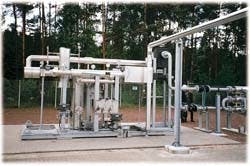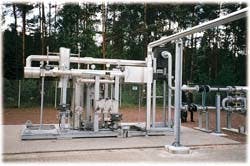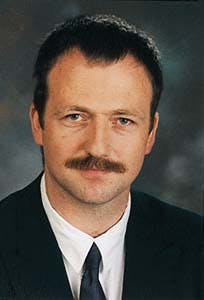Brock Hajdik
CBS Engineering Inc.
HoustonManfred Lorey
Filtan Anlagenbau GmbH
Langenselbold, GermanyJürgen Steinle
BEB Erdöl & Erdgas GmbH,
Hannover, GermanyKeith Thomas
Falk & Thomas Engineering GmbH,
Wettenberg, Germany
A vortex-tube unit treats 14 MMscfd of gas at a wellhead in northern Germany.Use of a vortex-tube device yields improved inlet gas-liquid separation, when compared with a Joule-Thomson system, but is less costly and complex than a true isentropic system, such as a turboexpander.
Because the vortex-tube unit provides separation as well as pressure reduction, the capital cost of a Joule-Thomson system with valve and separator will be similar to that of the vortex-tube system.
Future applications of vortex-tube units will be concentrated where performance improvements over Joule-Thomson units, at low capital cost, are required.
The comparative advantage of the vortex tube depends upon the inlet conditions of the gas and the available pressure drop. An optimum drop of 25-35% of the inlet-gas pressure has been confirmed in practice.
Units with up to 5% liquid at the inlet have been successfully operated, showing that a single-phase gas at the unit inlet is not essential.
Although the vortex-tube device has not yet been tested in an operating unit with inlet liquid-to-gas ratios greater than 20%, the device is not expected to perform as well. Therefore, an inlet separator would be necessary upstream of the device.
Some history
Original research on the cooling capabilities of vortexes was performed in the 1930s. 1 In the 1940s, further investigation of the cooling characteristics of vortexes identified the relationships between flow distribution and the resulting temperature effects on the two produced gas streams. 2Ranque-Hilsch tubes are now an established product, used primarily for generating cold air in applications such as cooling machine tools.
The working principle of a Ranque-Hilsch tube is simple (Fig. 1) [17,681 bytes]. A gas, usually air, is injected tangentially to the tube axis through a nozzle into the center of a tube where it is allowed to expand.
Following expansion, the gas picks up speed and moves cyclonically along the tube to the far end. During this flow, as a result of varying radial vapor, a pressure profile forms in the tube, with low pressure at the tube center and high pressure at the tube wall.
As velocity and pressure link, the flow at the center of the tube actually reverses. As it moves along the tube, two temperature zones are formed, a warm zone near the tube wall and a cooler zone near to the center. At the end of the Ranque-Hilsch tube, the core gas is deflected and returns along the tube through an orifice near the inlet nozzle.
The Ranque-Hilsch tube is, therefore, capable of generating two gas streams with different temperatures. Most significantly, all the gas has been subjected to cooling by isenthalpic (Joule-Thomson) expansion. The cold gas stream, however, is at a temperature less than that achievable through isenthalpic expansion (Fig. 1).
The cause of the temperature separation within the vortex-tube system has never been fully explained. The two main factors causing the temperature separation may be heat transfer, caused by temperature and pressure gradients in the expansion and contraction of eddies, and turbulent shear work done within the system by the counter-current flowing core and outer flow regimes.
Of the two factors, shear work dominates. Expressed simply, the gas performs work, through shearing and friction, upon itself. The gas spinning toward the wall of the tube is heated by friction.
Because the system has no moving parts, the energy for this heating can only come from within the system. Hence, for the outer annular flow to warm, the inner core must give up energy.
As the gas in the core was initially at the isenthalpic expansion temperature, its outlet temperature must now be less than this. The temperature of the warm gas will be correspondingly higher.
The Ranque-Hilsch effect can create streams with a temperature difference of 80° C. (144° F.). If the two gas streams are combined at the outlet of the device, the mixed stream temperature becomes equal to that achieved by isenthalpic expansion.
Thus, the system does not contravene the first and second laws of thermodynamics. It has no net loss or gain in enthalpy and a positive entropy change.
Although the Ranque-Hilsch effect is a simple and effective way of cooling gas, it has a significant drawback that has prevented its large-scale use as a refrigeration device. The forced vortex flow depends upon pressure energy, utilizing pressure drop during the expansion as its driving force.
In the case of air, a compressor is required to raise the pressure before expansion. The efficiency of the system, as a ratio of cooling achieved to compression energy required, is low at 10-15%.
For a Ranque-Hilsch application to be economical, the gas must be at a higher pressure than required at the outlet of the process.
In the gas industry, high-pressure gas can be a hindrance because of hydrate and condensate formation during pressure reduction. Additionally, at typical wellhead compositions and conditions, natural gas deviates significantly from ideal conditions.
It is reasonable to expect the Ranque-Hilsch effect to be more pronounced in a hydrocarbon-gas system than an air system. The density of hydrocarbon gases is also significantly higher than typical air systems. It can, therefore, be expected that shear effects, the dominant source of temperature separation within the vortex tube, are increased in a natural-gas system.
Separation
Although the basic principles of the technology have been known since the 1940s, Ranque-Hilsch has found little application in the gas-processing industry. A possible reason for this is that the standard Ranque-Hilsch tubes used for cooling are not ideal for performing nonequilibrium separations.To obtain the best possible separation, a device is required which simultaneously produces cooling and efficiently removes condensate. The basic layout of such a vortex tube device can be seen in (Fig. 2) [17,867 bytes].
Here gas is introduced through one or several nozzles tangentially to the tube's axis at one end of the vortex tube. The nozzles and inlet chamber are configured to achieve a gas velocity approaching mach 1.
At this point, the expansion is isenthalpic. The gas is at a temperature reproducible with a Joule-Thomson system. This means that even a poorly operating vortex tube should always be able to match the performance of a Joule-Thomson system.
The gas, following expansion, spins at a high radial velocity along the vortex tube.
Condensate, formed by the temperature reduction across the nozzle, is thrown to the tube wall as the gas enters a forced vortex zone. Within this zone, centrifugal forces in excess of 100,000 g exist. (This is significantly higher than most separation devices and results in even very small particles being thrown to the tube wall for recovery.)
The gas continues moving axially along the tube with a temperature gradient developing between the outer annulus and the inner core flow.
As a result of the shear work in the system, the temperature of the gas in the inner core sinks below the Joule-Thomson temperature. This drop in temperature causes additional condensation to occur.
The liquid, significantly denser than the gas phase, is thrown by the high centrifugal forces to the tube wall where it is separated from the gas.
At the end of the vortex tube, the cold inner core of the gas is deflected by a cone. The warm gas around the outer annulus of the tube is withdrawn. The cold gas stream, following deflection, is subject to flow reversal. The inner core returns counter to the forced vortex along the axis of the tube and exits at the inlet end.
During removal of condensate at the tube wall, a certain amount of gas is entrained. The entrained gas and condensate are collected in a separator mounted below the vortex tube to allow for gas-liquid separation.
The pressure of this separator gas is typically 3-5 psi higher than that of the cold gas stream. Consequently, it is combined with the cold gas downstream of the device. This allows for a basic stabilization of the gas within the system.
The warm and cold gas streams are then combined in the device's outlet piping. Depending upon how much condensate is removed, the resulting gas stream has a temperature equivalent to that of a Joule-Thomson system.
Applications
The operating characteristics of a vortex tube permit gas, in part, to be reduced in temperature to less than that normally achievable through isenthalpic expansion. It is possible to apply vortex tubes where traditional Joule-Thomson are unable to provide gas at the required specification.The following three examples show how vortex technology can be applied to achieve these aims.
Gas-letdown station
A German utility regularly observed the fallout of condensate at a pressure-letdown station, particularly during periods of low ambient temperature. This condition required a preheat station because the condensate disturbed the downstream metering system.To eliminate the problem, a vortex tube was installed upstream of the pressure reduction and metering system. The aim was to remove any unwanted condensate before it entered the metering facility without preheating.
The gas being treated was from the German grid system which had been previously treated to pipeline specification. An analysis showed it to have a phase envelope as shown in (Fig. 3) [24,112 bytes].
As can be seen there, for temperatures greater than 0° C. (32° F.) no condensate should be present.
The vortex tube has been in operation since 1993. Immediately following its commissioning, small quantities of condensate were removed regularly from the condensate tank of the vortex tube. During this period, the unit was operating with a pressure reduction of 13 to 8 bara (188.5 to 116 psia).
To achieve condensate fallout by conventional Joule-Thomson technology, an inlet temperature of -2.5° C. (27.5° F.) would be required. The temperature at the inlet of the system was approximately 9° C. during this period. The ambient temperature varied between 10° and 5° C. (50° F. and 41° F.).
Typical measured operating characteristics of the unit can be seen in (Fig. 4) [24,076 bytes]. The data indicate that the cold gas stream at 2° C. (35.6° F.) is below a temperature theoretically possible by isenthalpic expansion, 5° C. (41° F.).
This also confirmed that the vortex-tube system was able to produce two gas streams of varying temperatures. Adjusting the relative flows of the warm and cold gas streams minimized the cold gas-stream temperature. (This varied in the range of 25 to 40% cold-gas flow to total inlet flow and corresponds with experimental data gathered from laboratory vortex tube systems.)
Depending upon the thermodynamics of the system, it is possible to select a relationship of cold-gas temperature and mass flow which will maximize the possible condensate recovery. It has been proven, however, that the lowest possible cold gas-stream temperature will not always lead to maximum condensate recovery. Each system must be evaluated independently.
The unit has been operating with the following parameters: throughput, 300-30,000 std. cu m/hr (0.254-25.4 MMscfd); inlet pressures, 9-15 bara (130-217 psia); outlet pressures, 5-8 bara (72-16 psia); and inlet temperatures, 0-15° C. (32-59° F.).
Even during periods of warm weather, with inlet temperatures 8° C. (46° F.) and greater, it was possible to remove condensate from the vortex-tube condensate tank. This clearly indicates a separation was being achieved within the device beyond that expected from a purely isenthalpic process.
The operator reported no condensate fallout downstream of the vortex-tube unit, leading to a reduction in the energy use for the final pressure letdown stage of approximately 50 kw (approximately 170,600 BTU/hr) based on a flow of 30,000 std. cu m/hr (25.4 MMscfd).
Inspection of the unit during plant shutdown revealed that the vortex tube has shown no sign of corrosion either in the nozzle area or the tube itself.
Dew pointing facility
A North German operating company produces gas from a wellhead where it is dried with triethylene glycol (TEG) and then fed to a distribution system. Changes in wellhead gas composition resulted in an increase of heavy hydrocarbons and aromatics.The water dew point of the gas remained satisfactory. With the hydrocarbon dew point altered, however, it was impossible to ensure that hydrocarbon condensation would not occur at downstream conditions.
It was decided to treat a stream, being withdrawn by a local utility company, with a vortex tube-system. This would allow direct assessment of any improvement in downstream conditions achieved using the vortex tube. (Fig. 5) [27,168 bytes] shows the flow of this system.
The gas throughput of the unit changed greatly within short time periods, making a reliable control system to maintain the system efficiency essential. In order to achieve this, a header manifold with four nozzles was used, each equipped with a control valve.
With this arrangement, it was possible to maintain near-sonic velocities in the device despite an operating range of 10-100% design. This control system has been patented in Europe and the U.S.
In the facility, gas from the TEG system passes through a gas-gas exchanger before entering the vortex tube. In order to cope with a large throughput range, the valves on the manifold open and close, maintaining the gas at the required, near-sonic velocity.
To assess the efficiency of the system as a separating device, a second, high-efficiency separator was installed downstream of the normal vortex tube separating vessel.
The flash and entrained gas from the separating vessel was passed through the high-efficiency separator before being mixed with the cold-gas stream. Any liquid found in the vessel will be a result of liquid re-entrainment from the vortex-tube system.
Following commissioning in July 1996, the system was operated continuously. At the end of November 1996, tests were carried out by the operating company to assess whether the system had met its process guarantee.
(Fig. 6) [30,691 bytes]shows the dew point curves of the inlet and outlet streams of the vortex-tube system.
Typical operating data, recorded in December 1996, are shown in Table 1.
Considerable dew point suppression was achieved with a modest pressure drop. The operating company carried out dew point tests, a regular part of the quality control activity for the German gas-distribution network (ISO 6570 "Determination of Potential Hydrocarbon Liquid Content").
At a temperature of -14° C. (7° F.), no condensate was found either at operating conditions or in the retrograde area. This result matches the phase envelope for the outlet gas composition (Fig. 5).
A regular examination of the high-performance separator revealed no carryover of condensate from the vortex-tube separator. It is reasonable to assume, therefore, that the re-entrainment from the vortex device was negligible.
The tests proved two points:
- The vortex tube was able to achieve a better separation than that obtained by Joule-Thomson expansion.
- It is possible to yield an equivalent separation with a reduced pressure drop.
Turboexpander bypass: theory
Traditionally, turboexpander units have been equipped with Joule-Thomson valves as a bypass to ensure that downstream equipment receives feed should the turboexpander go down. The nonequilibrium nature of the vortex-tube separation allows it to be a viable substitute.The vortex-tube allows for increased liquid feed to downstream equipment during turboexpander downtime. This increase in feed results in recoveries of LPG which exceed the Joule-Thomson system.
A process simulator was used to predict the gains possible with a vortex-tube device in a turboexpander facility. A flow diagram and operating conditions for the system are shown in (Fig. 7) [37,756 bytes].
Gas is fed, via a gas-gas heat exchanger and chiller, across a Joule-Thomson valve to a separator. Here the heavier, condensed hydrocarbons are separated and fed to the column.
The gas phase is passed to a turboexpander where it is further reduced in pressure, and the gas and liquid phases are fed to separate trays in a de-ethanizer column. The de-ethanizer is a simple reboiled stabilizer column. The operating parameter was set at 97% ethane recovery for the gas leaving the unit.
With LPG recovery using a turboexpander system established, the unit was further simulated substituting a vortex tube and Joule-Thomson valve into the system.
The overall heat-transfer coefficient (UA) of the gas-gas heat exchanger and duty of the chiller unit were fixed at the same values as in the turboexpander unit. The recovery of the de-ethanizer unit was maintained at 97% ethane.
(Fig. 8) [25,632 bytes] shows that the recovery of LPG using the vortex-tube system was 8,754 lb/hr, compared to 8,713 lb/hr using the Joule-Thomson valve.
The amount of LPG recovered, therefore, increases only slightly with a vortex tube under the conditions simulated. The driving force, however, for the level of LPG recovery in this case, is an ethane-recovery specification of 97%.
If the level of C3+ hydrocarbon condensate leaving the pressure-reduction device (turboexpander, vortex-tube, or J-T valve) is taken as a parameter, the results are as shown in (Fig. 9) [26,132 bytes].
From these results, it is possible to see that more hydrocarbon liquids are recovered from the vortex-tube system than the turboexpander system. The reason for this is that the precooling of the gas is less efficient than that obtained by the turboexpander's lower return temperatures to the gas-gas heat exchanger, making the gas richer in heavier hydrocarbons entering the vortex-tube.
Consequently, the level of C3+ condensate leaving the vortex-tube system is double that of the Joule-Thomson system.
Further simulation confirmed that a relaxation of the ethane-recovery specification from the de-ethanizer led to an increase in the level of LPG recovered from the vortex-tube system relative to the Joule-Thomson system.
Acknowledgment
The authors wish to thank the following companies which have made data available: Main Gas, Frankfurt a/m, and BEB Erdöl & Erdgas, Hannover.References
- Ranque, G.L., "Expériences sur la detente giratoire avec productions simultan d'un cappement d'air chaud et d'un chappement d'air froid," Journal Physique Radium, Vol. 7 (1933), pp. 112-14.
- Hilsch, R., "Die Expansion von Gasen im Zentrifugalfeld als Kälteprozess." Zeit, Naturforschung, Vol. 1 (1946), pp. 208-14.
The Authors
Brock R. Hajdik is a lead engineer at CBS Engineering Inc., Houston, and has previously worked for Bryan Research & Engineering, Bryan, Tex. He holds a BS in chemical engineering from Texas A&M University.
Manfred Lorey is managing director for Filtan Anlagenbau GmbH, Langenselbold, Germany, which he founded after serving as a general sales manager for the Fram Corp. in Central Europe.
Jurgen Steinle has worked for BEB Erd"l & Erdgas GmbH, Hannover, in the technical planning department since graduating in chemistry from the University of Karlsrue. He also holds a doctorate from the University of Karlsrue in gas combustion at high pressures to 5,000 bar.
Keith Thomas is managing director for Falk & Thomas Engineering GmbH, Wettenberg, Germany, and has worked as a process engineer with Zimmer/Davy Mckee, DSD Dillinger Stahlbau GmbH, and Sulzer Chemtech. He holds a degree in chemical engineering from University of Teesside, U.K.
Copyright 1997 Oil & Gas Journal. All Rights Reserved.







